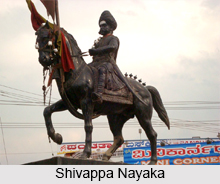 Shivappa Nayaka is a notable and famous ruler in Nayaka Dynasty in Southern part of India. He belongs to Keladi Nayaka Kingdom.
Shivappa Nayaka is a notable and famous ruler in Nayaka Dynasty in Southern part of India. He belongs to Keladi Nayaka Kingdom.
Rule of Shivappa Nayaka
Shivappa Nayaka ruled the entire part of Karnataka from 1645 to 1660. He was popularly known as Keladi Shivappa Nayaka, was a notable ruler of the Keladi Nayaka Kingdom.
Descendant of Keladi Nayakas
Keladi Nayakas were successors of the Vijayanagara Empire in the coastal and Malnad (hill) districts of Karnataka, in the late 16th century. At their peak, the Nayakas built a niche kingdom comprising the coastal, hill and some interior districts (Bayaluseeme) of modern Karnataka, before succumbing to the Kingdom of Mysore in 1763, which at that time was ruled by Hyder Ali. He was known as Sistina Shivappa Nayaka because he introduced a tax system called Sist.
Administration under Shivappa Nayaka
Shivappa Nayaka is remembered as an able administrator and soldier. He ascended the throne in 1645. During this time, the last ruler of the diminished Vijayanagara Empire ruling from Vellore, Shriranga Raya III was defeated by the Bijapur Sultanate and sought refuge with Shivappa. The growing threat of the Portuguese was eliminated by 1653 and the ports of Mangalore, Kundapura and Honnavar were brought under Keladi control. Having conquered the Kannada coast, he marched down to Kasargod region of modern Kerala and installed a pillar of victory at Nileshvara. The forts of Chandragiri, Bekal and Mangalore were built by Shivappa Nayaka.
Invasion of Shivappa Nayaka
Shivappa Nayaka invaded north of the Tungabhadra River and captured territory in the modern Dharwad district from the Bijapur Sultanate. In the south, when Shivappa Nayaka invaded and laid siege to Srirangapatna in modern Mysore district, an epidemic broke out in his army forcing him to withdraw. In the south, Shivappa Nayaka destroyed the Portuguese political power in the Kanara region by capturing all the Portuguese forts of the coastal region.
Revenue System introduced by Shivappa Nayaka
Shivappa Nayaka introduced a revenue settlement scheme called Sist, a policy that has found favourable comparison to revenue schemes formulated by the Mughal emperor Akbar. According to this scheme, agricultural lands were divided into five types depending on the type of soil and available irrigational facilities. A unit of sowing capacity called Khanduga was developed and every irrigable land was taxed in varying amounts based on this unit. The rate of taxation depended on the yield in each one of these five types of land, the rate varying from village to village and amounting to a third of the total yield. Shivappa Nayaka gave importance to agriculture which resulted in an expanding agrarian economy.
Religious Reformation of Shivappa Nayaka
Shivappa Nayaka was a religious and tolerant man. Shivappa Nayaka performed Vedic sacrifices and rituals and patronised the Hindu Advaita order of Sringeri. He was tolerant towards Christians and gave them land to cultivate. He encouraged the mercantile communities of South India such as the Komatis and Konkanis to settle down and establish businesses in his kingdom.






































